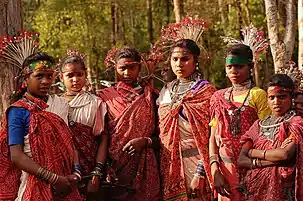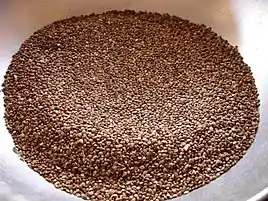Baiga tribe
The Baiga are an ethnic group found in central India primarily in the state of Madhya Pradesh, and in smaller numbers in the surrounding states of Uttar Pradesh, Chhattisgarh and Jharkhand. The largest number of Baiga is found in Baiga-chuk in Mandla district and Balaghat district of Madhya Pradesh. They have sub-castes: Bijhwar, Narotia, Bharotiya, Nahar, Rai Bhain and Kadh Bhaina. The name Baiga means "sorcerer- medicine man".
 Baiga women in traditional dress | |
| Regions with significant populations | |
|---|---|
| Madhya Pradesh | 414,526[1] |
| Chhattisgarh | 89,744 |
| Uttar Pradesh | 47,393 |
| Jharkhand | 3,585 |
| Languages | |
| Chhattisgarhi • Hindi • Regional languages | |
Demographics
The Baiga are designated as a Scheduled tribe in much of Uttar Pradesh. The 2011 Census of India for that state showed those so classified as numbering 17,387.[2] They are, however, designated as a Scheduled Tribe in Sonbhadra district.[3]
Livelihood
The Baiga do not plow the land, because they say it would be a sin to scratch the breast of their Mother, and they could never ask their Mother to produce food from the same patch of earth time and time again: she would have become weakened. The Baiga tribes practice shifting cultivation, called 'bewar' or 'dahiya'.[4]
Live-in relationships are common among the Baiga. If marriage does take place, the man compensates the woman's family for the loss of a working member. This reverse dowry either involves footing the bill of the marriage celebration or offering the woman's family mahua liquor. If divorced, the new husband must compensate the old one for the dowry amount. If the divorced couple have children, the wife has the first right, followed by the husband. If neither wants to raise the child, the community will allot a guardian to the child until age 15.
The Baigas in Chhattisgarh are classified as Particularly vulnerable tribal group(PVTG) by Government due to their declining population and low level of literacy.The Government of India has notified 75 PVTG which reside in 18 states and one UT which are classified on the basis of five criteria and in Chhattisgarh Baigas along with Abhujmaria, Kamar, Pahadi Korwa and Birhor are included in this group.The women of these tribes were not provided reproductive rights like right to use contraceptives but in 2018 on a Public Interest Litigation Chhattisgarh High Court allowed them to have access to contraceptives. The Baigas were found to be highly focused on family planning.[5]
Culture
Language
It is believed that the ancestors of the Baigas spoke an Austroasiatic language, however no trace of it is left now. Some Baigas (specifically those from the Mandla district) have mentioned "Baigani" as their mother tongue in the past: Baigani is now recognised as a variety of Chhattisgarhi influenced by Gondi.[6] Most Baigas speak Hindi, and some of them also know a few local languages such as Gondi and Marathi depending on the region where they live.
Tattooing

Tattooing is an integral part of their lifestyle. This tribe inhabits the dense hilly forests in the eastern part of the Satpuras, in Shahdol, Bilaspur, Rajnandgaon, Mandla and Balaghat districts.[7]
It is believed that this tribe is an offshoot of the Bhuiya tribe of Chhota Nagpur. A distinguishing feature of the Baiga tribe is that their women are famous for sporting tattoos of various kinds on almost all parts of their body. The women who work as tattooing artists belong to the Ojha, Badni and Dewar tribes of Madhya Pradesh are called Godharins. They are extremely knowledgeable about the different types of tattoos preferred by various tribes. Their mothers traditionally pass on this knowledge to them. Tattooing amongst the tribals commences with the approach of winter and continues until summer.[7]
Cuisine

Baiga cuisine primarily consists of coarse grains, such as kodo millet and kutki, and involves very little flour. Another staple food of the baiga is pej, a drink that can be made from ground macca or from the water left from boiling rice. They supplement this diet with food from the forest, including many fruits and vegetables. They hunt, primarily fish and small mammals.
Forced evictions
Since the 1960s, the Baiga have been the victims of forced evictions at the hands of the Indian authorities.[8] These are often carried out in the name of conservation, in an attempt to protect the tiger populations,[9] but have disastrous consequences for the displaced communities.[10]
References
- "A-11 Individual Scheduled Tribe Primary Census Abstract Data and its Appendix". www.censusindia.gov.in. Office of the Registrar General & Census Commissioner, India. Retrieved 18 November 2017.
- "A-10 Individual Scheduled Caste Primary Census Abstract Data and its Appendix - Uttar Pradesh". Registrar General & Census Commissioner, India. Retrieved 4 February 2017.
- "State wise Scheduled Tribes — Uttar Pradesh" (PDF). Ministry of Tribal Affairs, Government of India. Archived from the original (PDF) on 23 November 2016. Retrieved 4 February 2017.
- "Baiga tribals become India's first community to get habitat rights". Retrieved 12 March 2018.
- Bhuyan, Anoo. "Tribal Women in Chhattisgarh Win Right to Access Contraception". The wire. Retrieved 1 September 2020.
- Linguistic survey of India, Volume 6 by George Abraham Grierson. Page 241.
- "The Tribune...Sunday Reading". www.tribuneindia.com. Retrieved 12 March 2018.
- http://www.galli.in/2011/08/out-of-junglethe-baigas-sayantan-bera.html, 'the village Bhanpur Khera was relocated from inside the Khana National Park (a critical tiger habitat) way back in 1968.'
- International, Survival. "Tiger Reserves, India". www.survivalinternational.org. Retrieved 13 July 2018.
- Menon, Meena (1 August 2012). "Relocation plan to nowhere land". Retrieved 21 April 2018 – via www.thehindu.com.
Further reading
- Prasad, Archana (1998). "The Baiga: Survival strategies and local economy in the Central Provinces". Studies in History. 14 (2): 325–348. doi:10.1177/025764309801400209.
External links
| Wikimedia Commons has media related to Baiga people. |